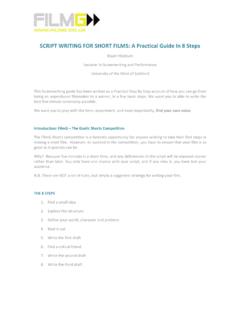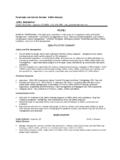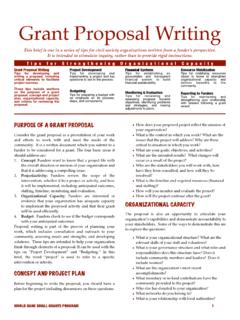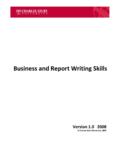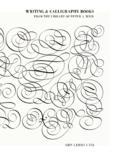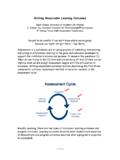Transcription of Technical Writing Guidelines
1 Technical Writing Guidelines September 1, 2004. Copyright 2004 by The Natchez Group Inc., dba TechProse. All rights reserved. The information disclosed herein is proprietary information owned by The Natchez Group Inc., dba TechProse ( TechProse ). This information shall be used solely and exclusively by University of Berkeley Extension students as part of their course and reference material for Technical Communication 1. The information herein shall be used by or disclosed to others only for this purpose. Published: January 2, 2003. Updated: September 1, 2004. Trademarks All trademarks in this document are held by their respective owners. Revision History Date Rev Description Author 12/16/2002 001 Initial Draft Meryl Natchez, Ann Tosello 1/2/2003 Final Draft Meryl Natchez, Linda Fogel 9/1/2004 Manual Review and Update Meryl Natchez Preface Preface TechProse is a Technical Writing , training, and information technology consulting company in business since 1982.
2 This manual provides Technical Writing guidance and sets standards for creating logical and professional written material. This manual is proprietary. TechProse provides it to staff writers, consultants, and students studying Technical Writing with a TechProse staff member. This manual describes the process of Writing good documentation. It is designed to be read from beginning to end, as well as to be used as a guide to refer back to once the material is familiar. TechProse staff follow this guidance in preparing all documents. Some of the material in this guide is based on problems that seem to arise for multiple projects. For example, many writers find the difficulty in Writing a report is knowing where to start.
3 The information in the Getting Started chapter is designed to help you determine the purpose, use, and audience of your document to facilitate getting started. Managers expressed concern that reports often are not logically organized, and that the same mistakes appear over and over. To remedy this, the chapters Correspondence &. Memoranda and Reports & Studies describe how to organize documents and put the tasks into perspective. In addition, the chapter Style & Usage can help you avoid the common mistakes that plague writers. Other concerns were that all employees exercise good judgment and ethical standards. The chapter Your Role As a Writer addresses professional and ethical conduct when Writing documentation.
4 Throughout this manual, we have used boldface to indicate key concepts. In addition, each chapter has a checklist at the end that focuses on the specific points in that chapter. The checklists provide a quick reference to make sure that writers have performed basic quality checks on draft materials prior to submitting them for review. Appendix B. provides a combined checklist that covers all points. You can use the checklist to perform a critical review of your own first draft documents, or submit the completed checklist with the draft to anyone asked to perform the review. An organization needs to maintain consistency in the look and feel of everything that carries its name.
5 This manual is one element in the effort to establish and maintain a high standard of quality for all TechProse materials. It is designed so that staff can continue to improve it over time. Specifically omitted from this manual are Guidelines on developing complete Technical guides, such as software user or developer manuals, maintenance manuals, or tutorials. We address these in a separate manual. Introduction to Technical Writing Rev , September 1, 2004. Table of Contents Table of Contents Chapter 1. Getting 1-1. Determine the Purpose and Use .. 1-1. Identify the Audience and What They 1-2. Determine the Level of 1-2. Organize the 1-3. When You Work with a Team .. 1-3. 1-4.
6 Summary .. 1-4. Checklist 1 Getting 1-5. Examples of Purpose and Audience 1-6. Chapter 2. Your Role as a Writer .. 2-1. Employ Ethical 2-1. Give Credit where 2-2. Summary .. 2-2. Checklist 2 Ethics .. 2-3. Chapter 3. Style & 3-1. Elements of Style .. 3-1. Present Tense, Active Voice .. 3-1. Simple Sentences .. 3-2. Gender Neutrality .. 3-2. Abbreviations and Acronyms .. 3-2. 3-3. 3-3. Figures and Tables .. 3-3. 3-4. Footnotes and Endnotes .. 3-4. 3-4. Final Edit .. 3-5. Wasted Words and Phrases to Avoid .. 3-5. Introduction to Technical Writing Rev , September 1, 2004. i Table of Contents A-Z Reference .. 3-7. Summary .. 3-10. Checklist 3 Editing .. 3-11. Sample Review Sign-off 3-12.
7 Chapter 4. Correspondence & Memoranda .. 4-1. Correspondence .. 4-1. Keep Comments within the Scope of the Organization's 4-1. Eliminate Personal Opinions .. 4-2. Use Proper Format .. 4-2. Email .. 4-2. State the Subject 4-3. Write Short, Readable 4-3. Employ Email 4-3. Meeting Agendas and Meeting Minutes .. 4-4. Meeting Agendas .. 4-4. Meeting Minutes .. 4-5. Memoranda .. 4-6. Technical 4-6. Documenting 4-7. Summary .. 4-8. Checklist 4 Correspondence & Memoranda .. 4-9. Samples and Templates .. 4-10. Sample Letter .. 4-11. Sample Technical 4-13. Sample Documenting 4-16. Technical Memorandum Template .. 4-17. Documenting Memorandum Template .. 4-18. Chapter 5. Reports & 5-1.
8 Report 5-1. Executive Summary A Stand-Alone Chapter .. 5-1. Summary Paragraphs .. 5-2. Main Body of the Report .. 5-3. 5-4. 5-5. 5-6. Rev , September 1, 2004 Introduction to Technical Writing ii Table of Contents Headings .. 5-7. Reference Information .. 5-7. Summary ..5-7. Checklist 5 Reports & Appendix A. Glossary .. A-1. Appendix B. Document Checklist ..B-1. Appendix C. Suggested C-1. Bibliography Introduction to Technical Writing Rev , September 1, 2004. iii Getting Started 1. Getting Started Writing well requires more than good grammar. To create a useful document, you need to express the purpose of the document and identify the audience for it. This chapter is designed to help you plan and complete Writing projects as simple as a memo or as complex as a software manual.
9 It covers how to: Define the purpose of the document and the key information it needs to convey Define the audience and their level of Technical understanding Determine the level of detail necessary for the document Organize the data Work with a team of authors Meet deadlines It provides a checklist and examples in the final pages of the chapter. Determine the Purpose and Use Establishing the purpose of a document is the first step in creating any written material. Determine what you want the readers to know or do when they have finished reading. This is often called task analysis. Be specific with your objectives. Ask yourself: Why does the reader need this information, and what do they need to do with it?
10 Answering this question generally provides a detailed objective that makes the document meaningful. For example, the objective to describe course improvements is too general. The objective to describe ways to make the curriculum of Technical Communication 1 more valuable to the novice Technical writer is a specific objective that helps define the information required. Writing the objective precisely, in terms of what and why, helps organize the material. As a test of whether you have adequately formulated your objective, try to make it measurable. For example: This document provides the information required for this audience to make appropriate decisions on specific course topics, exercises, and reference materials.
